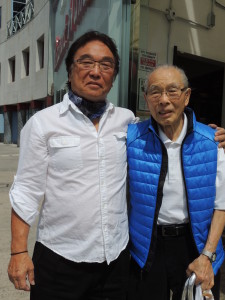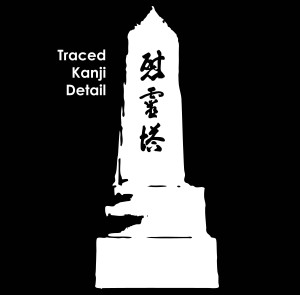ABOUT THE VJAMM COMMITTEE (updated October 7, 2021 by Phyllis Hayashibara)
On April 27, 2017, the Venice Japanese American Memorial Monument (VJAMM) Committee dedicated the VJAMM before a crowd of over 200 supporters sitting or standing on the northwest corner of Venice and Lincoln Boulevards. Guest speakers included Jim Smith of the Free Venice Beachhead Collective; Ruth Galanter, former Los Angeles City Councilmember, District 6; Joel Jacinto, Commissioner of the Los Angeles City Board of Public Works; Zev Yaroslavsky, former Los Angeles County Supervisor, District 3; Rachel Zaiden, Senior Field Deputy for Los Angeles County Supervisor Sheila Kuehl, District 3; Len Nguyen, Senior Field Deputy for Los Angeles City Councilmember Mike Bonin, District 11; Kevin McKeown, former Santa Monica City Mayor and current Councilmember; Jeff Burton, Cultural Resources Manager at Manzanar National Historic Site; Dr. Jimmy Hara, born in Gila River, Arizona; and Dr. Thomas Yoshikawa, former Manzanar internee. Warren Furutani, long-time community activist and Manzanar Pilgrimage pioneer, delivered a dynamic keynote address in celebration of the VJAMM Committee’s seven-year journey to installation and dedication of the Venice Japanese American Memorial Monument.
The Venice Japanese American Memorial Monument (VJAMM) Committee, an ad hoc group comprised of former internees and concerned citizens, has been working together since 2010 to build a permanent memorial to honor the Americans of Japanese descent forcibly removed from Venice, Santa Monica, and Malibu and incarcerated at the War Relocation Authority camp at Manzanar for the duration of World War II. The inspiration for this project goes back to the attacks against the World Trade Center in New York, the Pentagon in Virginia, and one that crashed into a field near Shanksville, Pennsylvania on September 11, 2001. Hate crimes against persons perceived to be Middle Easterners or Muslims flared, amid calls for their removal and imprisonment. Artists and activists of Venice drew comparisons with this prejudice and that which followed Imperial Japan’s attack on the U. S. naval base at Pearl Harbor, Hawaii on December 7, 1941. They sought to remind people that what happened to persons of Japanese ancestry in 1942 should never happen again to any minority group solely based on ethnicity or religion.
In April, 2009, the Free Venice Beachhead published a commemorative article on the Japanese American internment by Scott Ueda (erroneously spelled Yuda), titled, “It Did Happen Here: When our Japanese neighbors were sent to concentration camps,” and printed a 1942 photo of Japanese Americans lined up on Venice Boulevard just west of Lincoln Boulevard, for transport to Manzanar. Student Scott Pine brought the April 2009 issue of the Free Venice Beachhead to his U. S. History class in the New Media Academy at Venice High School for a current events discussion. Teacher Phyllis Hayashibara encouraged her students to heed the Beachhead’s urgent plea to urge 11th District Los Angeles City Councilmember Bill Rosendahl to support the installation of a permanent marker at the northwest corner of Venice and Lincoln Boulevards. Then-Councilmember Rosendahl invited the students to make a presentation before the Los Angeles City Council at City Hall in May 2009, and pledged his support.
The ad hoc Venice Japanese American Memorial Marker Committee met for the first time in March 2010. Activists in the Venice community and the Japanese American community came together after reading the students’ emails and names printed in the June and July 2009 issues of the Free Venice Beachhead. These activists included members of the Venice Arts Council, Free Venice Beachhead Collective, Venice Peace and Freedom Party, Venice Historical Society, Venice High School, Manzanar Committee, and former internees of the War Relocation Center at Manzanar. Students, churches, community organizations, and other elected officials pledged support for an enduring reminder of what had happened at this intersection in 1942, so that such an injustice would never happen again.
In June, 2016, the VJAMM Committee agreed to change its name from Marker to Monument, in recognition of the in recognition of the new, monumental design of the VJAMM obelisk’s 9 foot 6 inch height and its 3 foot by 3 foot base. The solid black granite VJAMM obelisk echoes the shape of the iconic white obelisk erected in 1943 for the cemetery at the War Relocation Authority camp at Manzanar. The three kanji characters on the front of the Manzanar cemetery obelisk read, I REI TO, which means “monument to console the dead.” The VJAMM obelisk seeks to inspire the living to know and exercise one’s Constitutional rights, so that violations of the writ of habeas corpus or due process will never again be visited upon any other minority group.
The VJAMM Committee has raised over $150,000.00 through April, 2019. This includes a $50,000 matching grant from the National Park Service Japanese American Confinement Sites program; over $20,000 donated by Esther and Jung Chaing over seven years of hosting the VJAMM special lunch bento and dinner fundraisers at Hama Sushi Restaurant in Venice; $10,000 raised at a VJAMM benefit at Beyond Baroque, $1,700 from the Abbott Kinney Festival Association for Educational Outreach, and $1,300 from the Venice Neighborhood Council. George and Stephanie Sakioka made a special donation In Loving Memory of Johnny Katsui Sakioka. Donors of $5,000 include former 11th District Los Angeles City Councilmember Bill Rosendahl, incumbent 11th District Los Angeles City Councilmember Mike Bonin, former 3rd District Los Angeles County Board of Supervisor Zev Yaroslavsky, incumbent 3rd District Los Angeles County Board of Supervisor Sheila Kuehl, 2nd District Los Angeles County Board of Supervisor Mark Ridley-Thomas, former 4th District Los Angeles County Board of Supervisor Don Knabe, 28th District California State Senator Ted Lieu (now U.S. Congressmember, California’s 33rd District), the Santa Monica City Council, the Malibu City Council, Arnold Maeda and Brian Maeda in memory of their parents Norman Toyoshige and Sasami Takeda Maeda, Alice Stek of the Venice Peace and Freedom Party, and Thomas and Catherine Yoshikawa, in loving memory of Isao and Kiyako Yoshikawa. Hundreds of individual donors have given between $10 and $1,000 each. The east-facing side of the VJAMM permanently acknowledges the major donors.
The front of the VJAMM obelisk of solid black granite, nine feet and six inches tall with a three feet by three feet base, features the 1942 photo, a three paragraph text, and the title, VENICE JAPANESE AMERICAN MEMORIAL MONUMENT:
IN APRIL 1942, DURING WORLD WAR II, MORE THAN A THOUSAND AMERICAN MEN, WOMEN, AND CHILDREN OF JAPANESE ANCESTRY IN VENICE, SANTA MONICA, AND MALIBU REPORTED TO THIS CORNER AT VENICE AND LINCOLN BOULEVARDS. THEY WERE ALLOWED TO BRING WITH THEM ONLY WHAT THEY COULD CARRY. THE WESTERN DEFENSE COMMAND AND FOURTH ARMY ISSUED CIVILIAN EXCLUSION ORDER NO. 7 WHICH GAVE FAMILIES ONLY DAYS TO DISPOSE OF THEIR PROPERTY AND POSSESSIONS. BUSES TRANSPORTED THEM DIRECTLY TO THE AMERICAN CONCENTRATION CAMP AT MANZANAR IN INYO COUNTY WHERE MANY INTERNEES WERE INCARCERATED FOR MORE THAN THREE YEARS.
JAPAN’S DECEMBER 7, 1941 ATTACK ON THE U.S. NAVAL BASE AT PEARL HARBOR IN HAWAII PLUNGED THE UNITED STATES INTO WORLD WAR II. WITHIN DAYS, THE DEPARTMENT OF JUSTICE PUT JAPANESE AMERICAN COMMUNITY LEADERS INTO DETENTION CENTERS FOR THE UNSUBSTANTIATED FEAR OF COLLUSION WITH THE ENEMY NATION OF JAPAN. ON FEBRUARY 19, 1942, PRESIDENT FRANKLIN DELANO ROOSEVELT SIGNED EXECUTIVE ORDER 9066, WHICH EMPOWERED THE U.S. ARMY TO DECLARE AREAS OF WASHINGTON, OREGON, AND CALIFORNIA MILITARILY SENSITIVE. EO 9066 FORCED THE REMOVAL OF 120,000 JAPANESE AND AMERICAN CITIZENS OF JAPANESE ANCESTRY FROM THE WEST COAST TO BE IMPRISONED IN TEMPORARY ASSEMBLY CENTERS AT FAIRGROUNDS AND RACE TRACKS. MONTHS LATER, THEY WERE TAKEN TO TEN AMERICAN CONCENTRATION CAMPS UNDER THE WAR RELOCATION AUTHORITY. THIS FORCED REMOVAL AND IMPRISONMENT, WITHOUT ANY REGARD TO DUE PROCESS OR THE WRIT OF HABEAS CORPUS, VIOLATED THEIR RIGHTS UNDER THE U.S. CONSTITUTION.
MAY THIS VENICE JAPANESE AMERICAN MEMORIAL MONUMENT REMIND US TO BE FOREVER VIGILANT ABOUT DEFENDING OUR CONSTITUTIONAL RIGHTS. THE POWERS OF GOVERNMENT MUST NEVER AGAIN PERPETRATE AN INJUSTICE AGAINST ANY GROUP BASED SOLELY ON ETHNICITY, GENDER, SEXUAL ORIENTATION, RACE, OR RELIGION.
The west-facing side of the VJAMM obelisk features quotes from former Manzanar internees:
My family reported to this very corner, before being sent to Manzanar concentration camp with only what they could carry. They, and many other families, lost everything: their homes, their businesses, their liberties.
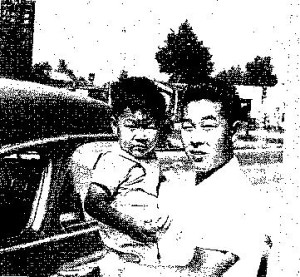 Brian and Arnold after the second world war
Brian and Arnold after the second world war
Instead of being worried about where we were going, I was obsessed with the fact that I had parted with my constant companion, my pet dog, Boy. For a fifteen-year-old, that was unforgettably traumatic.
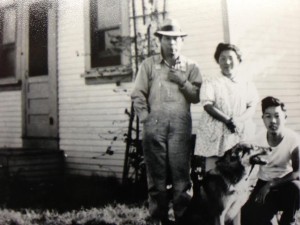 Toyoshige Norman Maeda, Sasami Maeda, Arnold, and “Boy” before forced removal from Santa Monica
Toyoshige Norman Maeda, Sasami Maeda, Arnold, and “Boy” before forced removal from Santa Monica
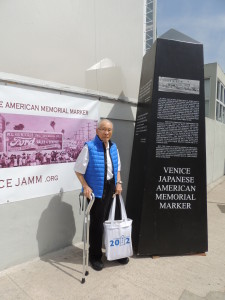 Arnold with VJAMM Model in 2014
Arnold with VJAMM Model in 2014
When the camp closed, we were given twenty-five dollars and told to leave. But we had nothing when we left camp – no home, no jobs, no prospects. It was very hard on all of us.
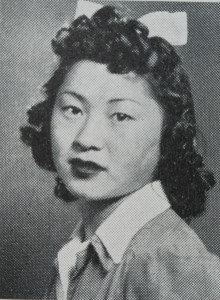 Mae Kageyama, Venice High School, Class of 1941
Mae Kageyama, Venice High School, Class of 1941
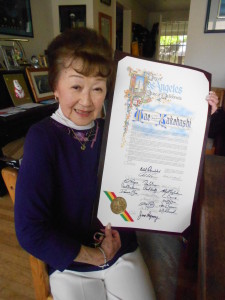 Mae Kageyama Kakehashi with 90th Birthday Resolution from the Los Angeles City Council
Mae Kageyama Kakehashi with 90th Birthday Resolution from the Los Angeles City Council
As a sixteen-year-old I didn’t realize the injustice fully, but in time we learned how our rights as citizens were ignored. Thanks to the strength and resilience of our Issei parents, we were able to survive.
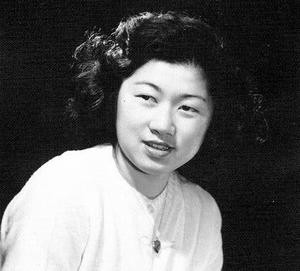 Amy Takahashi, Malibu High School Graduation
Amy Takahashi, Malibu High School Graduation
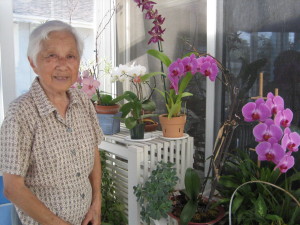 Amy Takahashi Ioki at home in 2012
Amy Takahashi Ioki at home in 2012
I was only five-years-old when we were imprisoned in Manzanar. I feel so grateful to the many Nisei and Sansei who worked successfully for redress and reparations with the passage of the Civil Liberties Act of 1988. I feel extremely grateful also to all the people in the community who came together to make the VJAMM a reality.
The back of the VJAMM obelisk features a description of the Manzanar War Relocation Authority camp, a map of the route from Venice, California to the Manzanar National Historic Site in Inyo County, an image of the white obelisk in the Manzanar cemetery with the three kanji, I REI TO, that translate to “monument to console the dead,” and a dedication date of April, 2017. Echoing the shape of the white Manzanar obelisk, the black VJAMM obelisk reminds those living in the present to remember the past, for a more just future for all.
The VJAMM Committee secured required civil engineering, structural engineering, and geotechnical (soil) engineering reports; and approvals and permits from the California Coastal Commission, the California Department of Transportation District 7, the Los Angeles City Council, the Los Angeles City Bureau of Street Services, the Los Angeles City Office of Community Beautification, the Los Angeles City Department of Cultural Affairs, the Los Angeles City Cultural Affairs Commission, and the Los Angeles City Board of Public Works Department of Engineering. The VJAMM appreciates the work of the Los Angeles City Construction Forces Division, in charge of the installation, including concrete foundation, crane work, and traffic mitigation; and especially the work of Certified Memorialist David Williams of Williams Monument Company in Arvin, California, for the fabrication of the solid, black granite obelisk, for the ceramic photograph, and for the meticulous, hand-sandblasted engravings of text.
Members of the VJAMM Committee continue to schedule educational outreach events and VJAMM maintenance with community youth groups. VJAMM Committee members include Kay Brown, Nikki Gilbert, Phyllis Hayashibara, Mae Kakehashi, Arnold Maeda (passed away on September 10, 2020), Brian Maeda, Alice Stek, Suzanne Thompson, Yosh Tomita (passed away on January, 2017), and Emily Winters. Former VJAMM Committee members include Don Geagan, Marc Salvatierra, Jim Smith, and Fred Yoshiyama (passed November 30, 2015).
For images of the VJAMM obelisk, lists of supporters, lists of donors, a timeline of the VJAMM Committee, photographs of VJAMM events, and a pdf of the VJAMM Dedication Program, and videos of the VJAMM Dedication speakers, please visit venicejamm.org.
The VJAMM Committee works in partnership with the Venice Arts Council,
P. O. Box 993, Venice, CA 90294 (www.veniceartscouncil.org)
where tax-deductible donations payable to VCH/VJAMM may be sent, and whose fiscal sponsor is Venice Community Housing, a 501(c)(3) non-profit organization, EIN #95-4200761,
200 Lincoln Boulevard, Venice, CA 90291 (310-399-4100) (www.vchcorp.org).
Please visit VJAMM at www.venicejamm.org.

